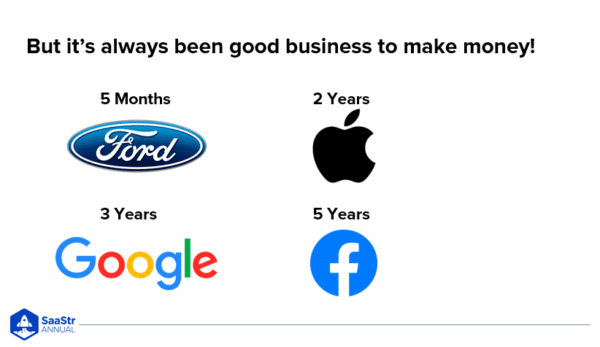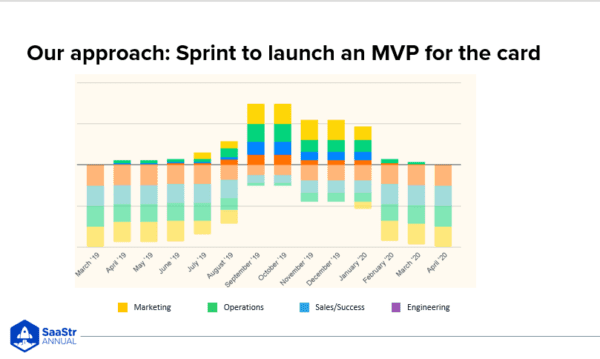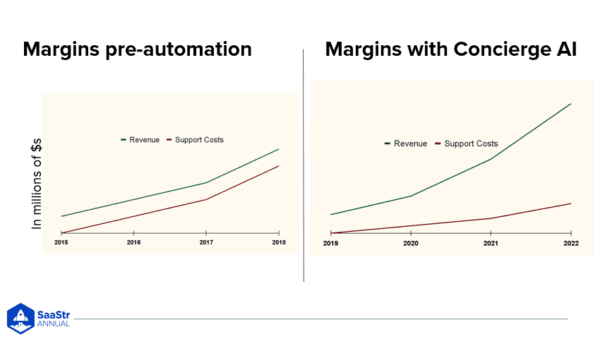How do you build a successful, high-growth company that is also profitable? Expensify’s COO, Anu Muralidharan, debunks the fallacy that profitability comes at the expense of growth.
Expensify is a cash-positive business and has been for five years now.
Anu has spent a few years pitching Expensify and explaining its performance to investors and is often met with curious stares before someone asks, “Why would you want to be cash-positive?”
As an industry, we’ve assumed all profitability comes at the expense of growth, but that’s just not true.
The Mythical Entity of High Growth and Profitability Could Be Your Company
It’s not exactly uncool to make money, and all kinds of companies experience high growth and profitability.

Even Ford, which isn’t a SaaS startup, is a capital-intensive business that achieved growth and profitability in a mere five months.
It’s possible to have high growth if you have a solid product and aspire to be profitable within a reasonably short time frame.
Expensify didn’t become cash-positive by accident.
It requires discipline and muscle memory for evaluating good growth opportunities.
If a growth opportunity is in front of you, ask yourself the following questions.
- Is it truly scalable?
- Can it have a meaningful impact?
- Is it a positive ROI?
If the answer’s no, is it still worth investing in at the expense of profitability?
Expensify always had a dual focus on growth and cost and process optimization, which helped them achieve profitability pretty early on in their life cycle.
Now, let’s look at some tried and true strategies that worked for Expensify, and maybe they’ll show you that you can have your cake and eat it, too.
Strategy #1: Iterate Using Real User Feedback
Make it a habit to iterate on your product using real user feedback.
It’s pretty obvious that your biggest ally is your product. It’s your biggest asset.
If your product has effortless growth or a word-of-mouth motion and momentum, it automatically takes care of one of your biggest cost drivers: sales and marketing.
For your product to have that kind of momentum and viral growth, it needs pretty incredible product market fit.
Incredible product market fit isn’t achieved by simply tinkering with your product and user experience in a lab behind closed doors.
It’s not even achieved by asking your customers what they want because people don’t know what they want, even if they think they do.
How Expensify Built One Of Their Major Features — The Expensify Card

The chart above shows Expensify’s approach to building and launching a major feature.
All the lines below the horizontal line are people that weren’t working on the card, and the brighter colors were working on it.
You can see that barely anyone worked on it around July or August 2019. It was just a pilot team evaluating the viability of the product.
Between August and December 2019, almost the entire company was working on it.
After it launched, a core team managed it, gathered feedback, and continued to iterate on the product.
If you’re launching something, assemble it as fast as you can and get it into the hands of users.
That day-to-day real usage will teach you a lot and give you better direction in terms of what will resonate with your audience.
A Key Challenge When Launching A Product
Expensify built and launched this new product in five months, but they couldn’t find a solution to a key challenge…
They couldn’t figure out how to support all those customers on 30-day balances.
As you can imagine, you need some pretty strong reserve cash balances sitting in an account with your processing bank to support a company for 30 days on a card.
They couldn’t build this quickly and figure out that critical fund piece in time, so they had two options.
- Launch the card and its features, but customers had to pay off the balance every day.
- Wait and figure out how to fund and launch it with the 30-day balances.
The 30-day balance was more “desirable.” Channel partners said if they couldn’t do a 30-day balance, it was dead in the water.
What did Expensify do?
Launched it anyway.
This was back in January of 2020 with COVID shutdowns. If they had waited, it would have taken almost a year or more before they could figure out funding needs.
Instead, they saw steady growth on the card regarding adoption and a lot of real user data to play with — how companies were using it, what they were missing, and how to build it into their everyday workflows.
If they waited, it might not have launched until 2021, and they’d miss out on valuable feedback.
But what about the less desirable daily balance payoff?
The daily balance is the default option today, although they can switch to 30 days if they want.
But most companies never switch.
The takeaway:
If you have a product that’s good enough as an MVP, put it in users’ hands. If you wait for perfection, you won’t really get there because the way to get from good to perfect is by using real feedback from real users based on real usage.
Strategy #2: Automate to Broaden Your Margins

Think about how you can automate to broaden your margins. You can probably rattle off the top three cost drivers of your business.
For Expensify, people-related expenses were a big driver for their business. If a product is at all nuanced, then a large portion of that people-related expense is probably support costs.
As they grew the platform, the number of active users grew, which meant revenue grew.
But, for every dollar of revenue they brought in, they had to spend almost a proportional amount for support.
The only way to stay ahead of support volume was to keep hiring into the support team.
Profitability was always just ahead of them, so they decided to automate this line item and use AI to do it.
How Expensify Automated Customer Support
The way Expensify automated support processes was a little different from the majority of the market.
Most companies automate support using natural language processing to guess what the customer is asking and then send them helpful articles in the hope that it’s self-service.
If someone still isn’t self-serviced, they go to a live agent.
This method works to a point. You take a percentage of support volume to self-service, but what remains will still grow proportional to your usage.
So, you never get ahead.
The way Expensify automated support was with a 3-tier process using natural language processing, not just to guess what the customer was asking, but to guess at the complexity of their question.
The three tiers include:
- The simplest tier where the answer is a multiple choice question.
- Mid-tier with simple questions that only require a response without the need for any deep product knowledge.
- The third tier was where Expensify was already staffing the most support agents troubleshooting customer accounts.
What they noticed was that a huge percentage of questions were very simple or mid-level. They weren’t super complex, so most went to lower tiers, and what remained went to the highest tier.
They never needed to increase the team size ever again, drastically cutting costs and changing the trajectory of support cost spend.
The takeaway:
Not all of your cost drivers are equal. You need to identify a material cost that is trending lockstep with your revenue and disassociate them to see a broadening of your margins.
Strategy #3: Outsource for Flexibility
How can you outsource, not for cost savings, but for flexibility, which in turn will help optimize your business for costs?
Let’s stick with the theme of people costs, not in terms of the actual dollar amount, but time spent keeping up morale and performance, etc.
When you increase team size, you have to think about all of those costs because they will all multiply together.
Sometimes…
It may be a better strategy to use an outsourced team.
How Expensify Experimented with Outsourcing a Team
Pre-COVID, Expensify had so much word-of-mouth growth that they never invested in scaling out their internal sales team.
After COVID, the world was a little different.
In late 2021, they decided to play with their sales motion more and bridge the gap in the volume of leads.
They wanted to build a team of cold-callers and onboarding specialists who could work one-on-one with the incoming leads to try and convert them at a higher percent faster.
But here’s the challenge…
They didn’t know if this would work or be viable.
There were a lot of question marks.
The work they needed done had attributes that would lend well to outsourcing.
They were:
- highly repeatable
- very trainable
Once trained, the training doesn’t need to change much because the product isn’t changing, so they decided to outsource instead of hiring a full-time sales team.
They tried it for a year and a half, and outsourcing allowed them to:
- Dial team sizes up and down based on cyclicality and time zones
- Explore offshoring to save on costs
- Experiment with multiple vendors for performance optimization
All of this would have been impossible with an internal team because:
- You’d have to spend time hiring them
- You couldn’t titrate their hours up and down
- You couldn’t play with time zones
It gave Expensify the flexibility to experiment and learn in a short timeframe.
What did they learn?
That outbound calling didn’t work for them from an economical perspective.
The moral of the story?
If you’re experimenting with ideas and are unsure about a strategy but would like to try it, consider outsourcing before committing to a full-time team.
Once you hire a team, there’s a soft cost. You can’t let everyone go because something isn’t working.
Outsourcing allows you to experiment and test many ideas before committing to them.
A Generalist Team Is Expensify’s Secret Sauce
Strategies are sort of like ideas. They’re cheap and a dime a dozen. No two companies are alike, so there is no one-size-fits-all approach.
The secret sauce for Expensify is a small but powerful generalist team.
When they hire, they look for specific job skills and three special qualities.
- Innate curiosity
- Ambition
- Humility
That’s what makes a generalist — someone who can identify a problem, go to the problem area, work with the people involved, and solve problems.
That’s what brought these strategies together and made the most impact on their business.
To be a generalist, you need a culture that nurtures generalists.
You need the free flow of information so they can identify problem areas. Generalists should be able to go to any area, work hard, and show you results. If they’re worried about politics and stepping on toes, it will never work.
If you enable your team to be generalists, the superstars will rise to the top, and you’ll build a strong company with strong fundamentals.

